Carl E. Olson's Blog, page 3
April 28, 2017
New: "Father Brown and the Ten Commandments: Selected Mystery Stories"
Now available from Ignatius Press:
Father Brown and the Ten Commandments: Selected Mystery Stories
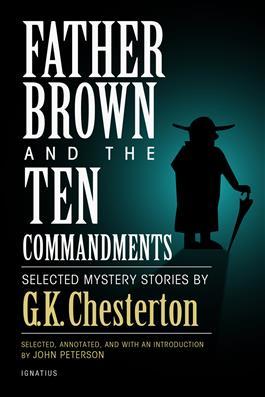
by G. K. Chesterton; edited by John Peterson
This unique collection of Father Brown mysteries links tales by G.K. Chesterton with the Ten Commandments. The connection is often surprising, however, for the criminal is not necessarily the worst sinner in the story, nor is his crime necessarily the worst offense.
When Chesterton created the character of Father Brown, he brought a new dimension to mystery stories—the distinction between crime and sin. As the priest-detective applies his powers of observation to solve a case, he picks up clues about other offenses, such as those against the Sabbath or one's parents. Father Brown's main concern is not the laws of the State but the Commandments of God.
As Dorothy Sayers once wrote, G.K. Chesterton was "the first man of our time to introduce the great name of God into a detective story . . . to enlarge the boundaries of the detective story by making it deal with death and real wickedness and real, that is to say, divine judgment."
This edition includes footnotes not available in other versions, which help to clarify the literary and historical allusions made by Father Brown. It is based on the texts of Chesterton's original editions, for assurance of authenticity, and is set in easily readable type.
G. K. Chesterton was one of the most beloved writers of the 20th century, quoted more often than any other writer. He wrote dozens of popular books on numerous topics, as well as thousands of essays. His books include Orthodoxy, The Everlasting Man, The Man Who Was Thursday, Father Brown Stories and many more.
"John Peterson is the world's greatest expert on Chesterton's famous priest-detective. His presentation of these particular Father Brown stories only adds to their craftiness and profundity."
— Dale Ahlquist, President, American Chesterton Society
"Chesterton wore many hats—as an apologist, a biographer, a critic, a journalist and more. For many he is best known and loved as the inventor of the incomparable Father Brown. It is, therefore, a joy to see this new vintage collection of Father Brown stories brought together by the venerable and veteran Chestertonian John Peterson."
— Joseph Pearce, Author, Wisdom and Innocence: The Life of G.K. Chesterton
"This is an excellent edition of selected Father Brown stories and a fitting tribute to Chesterton's lovable sleuth and saver of souls. Using the Ten Commandments as a template, the stories are carefully annotated for the modern reader, introducing Chesterton's sparkling English wit, charm and insight to a new generation of fans."
— Fiorella De Maria, Author, The Sleeping Witness: A Father Gabriel Mystery
"Father Brown stories stand in stark contrast to twenty-first century mysteries that portray a hopelessly disordered world. For Chesterton, the world is messy because of sin, but its Creator is actively engaged in it."
— T.M. Doran, Author,Toward the Gleam
Settle for nothing less than the infinite mystery and infinite delight

The sky at the Cerro Tololo in the Valle de Elqui, Chile, is seen Oct. 11, 2015. (CNS photo/AURA Observatory of Chile via EPA)
Settle for nothing less than the infinite mystery and infinite delight | Carl E. Olson | Catholic World Report
The recent March for Science was a sad and sorry exercise in a view of reality that is flattened, dreary, and ultimately inhuman
Back in the early 1840s, John Henry Newman observed that physical philosophers—that is, scientists—"are ever inquiring whence things are, not why; referring them to nature, not to mind; and thus they tend to make a system a substitute for a God..." The "tending" has been, as they say, trending ever since. About a hundred years later, in 1948, Fulton Sheen remarked in his outstanding study Philosophy of Religion, that:
Science cannot give us a philosophy, not can it give us an ethics; it cannot give us a philosophy, because it immerses man in nature and avoids the important subject of his destiny. It cannot give us an ethics because science by itself is amoral. Morality comes from its ends, and science is indifferent to ends.
Lest it be thought that Sheen was anti-science or the enemy of scientists, consider his remark, from his 1928 book Religion Without God, that the "rock-surenes of 'Science' does not exist in the mind of the scientists themselves, although it does love and throb in the minds of publicists and propagandists. Scientists themselves disclaim they possess ultimate truth; rather they look upon it as a horizon toward which they are proceeding." Sheen was indicating that when a scientist begins to make metaphysical or philosophical assertions, he is no longer speaking as a scientist. Of course, a great number of famous scientists—Richard Dawkins and Stephen Hawking come to mind immediately—have used their scientific reputations in order to wade into waters that are better described as ideological and polemical. And even political.
All of those elements were obvious in the silly "March for Science" event that took place this past Saturday. I was blissfully unaware of the event until a friend sent a link to the local newspaper's coverage of the March for Science in Eugene, which featured some 1500 or so true believers. And I don't say "true believers" with any sarcasm or snarkiness; on the contrary:
“We teach science and we believe in science,” said Carrie Ann Naumoff, a fifth-grade teacher at Edison Elementary in Eugene. “We’re concerned that science is being blocked and interrupted. “We’re concerned about the EPA and concerned that scientists are being harassed for what they’re publishing. We want our students to have access to real information.”
"We believe in science." Whatever does that mean? What if the seventh-grade home-ec teacher (if such a thing still exists) exclaimed, "We believe in the culinary arts", or the 10th-grade French teacher solemnly explained, "We believe in language." Huh? But we do know what Ms. Naumoff means: she and the enlightened educating class are the guardians of science, which is the one, true source of truth and goodness, leading us into a future of, well, more science. However, such a belief is not really about scientific research and fact, but about a particular ideological perspective, generally called scientism, which is not about following physical evidence where it might lead, but flattening all of reality into the narrow confines of materialist proofs and premises.
Dr. Austin L. Hughes, a professor of Biological Sciences at the University of South Carolina, described it well in an 2012 essay titled "The Folly of Scientism":
April 17, 2017
New: "Slaves in Paradise: A Priest Stands Up for Exploited Sugarcane Workers" by Jesús García
Now available from Ignatius Press:
Slaves in Paradise: A Priest Stands Up for Exploited Sugarcane Workers
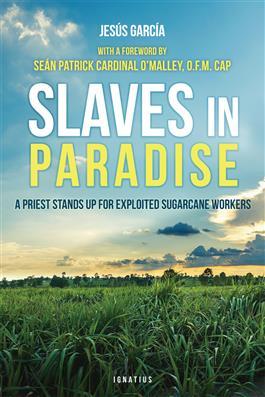
by Jesús García
With its beautiful beaches and golf courses, the island of the Dominican Republic is one of the most popular tourist destinations in the Caribbean. Yet when missionary priest Fr. Christopher Hartley arrived in the country in 1997, he discovered another side to this paradise: the deplorable living and working conditions of the people who harvest the country's sugarcane, and the illegal human trafficking that brings them to the plantations as slaves.
Inspired by the Gospels and Mother Teresa, Fr. Hartley carried out intense evangelization efforts in his large parish, which included several cane cutter camps. He brought the Good News of salvation in Christ and the sacraments of the Church to many workers and their families whose unjust treatment was being ignored at every level of society. Drawing from the social teachings of the Church, he denounced the exploitation, including in a speech before the president of the Dominican Republic and in meetings with the owners of the plantations. Because of his strong criticism, he endured harsh treatment, was threatened with death, and eventually had to leave the country.
This book chronicles Fr. Hartley's missionary work in the Dominican Republic. It includes detailed letters he wrote to his friends and benefactors about the needs of his people and the injustices they endured. Filled with rich spiritual reflections and apostolic passion, his letters tell heart-wrenching stories of human misery while revealing the deep and abiding faith he found among the poor.
Jesús García, a journalist for many years with the newspaper El Mundo, now works in the Department of Communication of Aid to the Church in Need. As a reporter of religious news and events, he has written numerous stories on the work of the Church in different countries of the world, and is the author of three other books.
"Fr. Hartley's mission of love is fueled by his strong prayer life and his intimacy with God. You will discover a man who always makes time for prayer, often spending hours before the Lord. I pray that this book will inspire us all to a deeper faith in God and love for the poor."
—Cardinal Seán O'Malley, O.F.M. Cap., Archbishop of Boston, from the Foreword
"A favorite son of Mother Teresa, Fr. Hartley shows us the face of Jesus in the people he served. This book, quite simply, should be read by everyone! Read it and allow Christ to open your eyes to see him in all people, especially the poorest of the poor."
—Fr. Larry Richards, Author, Be a Man!
"Evangelization is not just about believing in Jesus, but about touching his wounds in our wounded brothers and sisters. That changes the wounded and it changes us. Fr. Hartley's life was changed and ministry was born when he saw the suffering poor. This is not just his call, it's ours too, for the poor, the unborn, and all in need."
—Fr. Frank Pavone, National Director, Priests for Life
"This is a book that exudes hope, which generates the happiness and joy of living, and sparks a lively desire to do the same: to evangelize. The testimony of this beloved missionary priest transmits joy and light, as he transmitted that same joy and hope to those long-suffering brothers and sisters in the Dominican Republic."
—Cardinal Antonio Cañizares Llovera, from the Foreword to the Spanish Edition
But What Exactly is Easter?

Detail from "Resurrection" ("Воскресение", c.1892) by Mikhail Nesterov [Wikipedia]
But What Exactly is Easter? | Fr. James V. Schall, S.J. | CWR
"Christ, the Son of God, rose from the dead." In that brief sentence, if we look carefully enough, we can discover the whole order of being and our place within it.
I.
As a general principle, an honest man will want know what something is, or is said to be, before he decides whether he thinks it is true or that he must do anything about it. Take one’s relation to a doctor. Insofar as we deal with a doctor qua doctor, we want him to tell us the truth about what is wrong with us. If we didn’t, we should not bother him. We do not, if we are normal, want him to lie to us. Unless we know what the problem is, we cannot decide what, if anything, we need to do about it. And if we decide the doctor is incompetent, we still have to find one that is.
Definitions are good things. They are intended to tell us what a thing is in words we understand. Generally, we want to know what a thing is whether we like it or not. Indeed, we need to know what things can harm us and which ones help us. We understand that it is dangerous for us deliberately to choose not to know the truth about something. On the basis of what they are and of what we are, our knowledge relates us to everything that is not ourselves.
In the Easter season, someone who does not know much about what it means might well ask: “What exactly is Easter anyhow?” Accurate knowledge of it is not always easy to come by. Indeed, we have the impression that many people do not want to know what it really is lest it make a demand on them they are not willing to consider. Still, what would be a fair and accurate answer to an honest inquiry about Easter that had no further purpose but to hear accurately what this word and the reality to which it refers mean? On hearing the explication, the inquiring listener might say: “So that is what it means!” or “Makes no sense to me!” or “I had it all wrong” or “It’s really complicated” or “Run that by me again...” In any case, the question—“What is Easter?—is a worthy one.
II.
The word Easter can have several origins—an Anglo-Saxon goddess of Spring, a Frankish way of referring to the East and the rising Sun, a reference to the Jewish Passover. For Christians and anyone who wants to know about its meaning, it recalls the day on which Christ rose from the dead. Each of the three words—Christ, rose, dead—refers to a specific reality.
Taken in itself, “Christ rose from the dead” is a straight-forward statement of what Easter means, of what it is to which the sentence refers. Spelled out, it recalls that a young Jewish man, called Jesus Christ, claimed to be the Son of God. He was executed in Jerusalem under Roman authority about thirty years after his birth in Bethlehem. Contemporary witnesses maintained that three days after his execution on a Cross, he rose again from the dead. The same witnesses initially had a hard time believing this event, but they also had more difficulty in denying what they saw and touched. So they concluded that it was a fact that they witnessed.
“To rise again” means that the same individual, who was actually dead, reappeared, identified himself as the same person who died, though in a transfigured manner. Dead means what dead means. Life had ceased in him.
Once we understand what Easter means, we are not asked to accept this unexpected truth as if it had no justification. No one denies that most dead men stay dead. Even the two dead men whom this Christ was said to have brought back to life—the widow’s son and Lazarus—subsequently died. This did not happen to Christ.
Throughout subsequent history, many efforts have been made to explain how this event and its testimony could not be true. These efforts have their value. Each time this Resurrection is denied, something new about its reality comes to be understood. Muslims, for example, maintain that God cannot suffer. Therefore, Christ was not God and was not crucified. Some Jews just after Christ’s death were worried that the disciples would claim that he rose again, as he said he would, so they paid some soldiers to testify that the body was carried away at night. The disciples, in this scenario, only pretended that it rose again.
Many different theories were subsequently developed to explain what happened as if it did not or could not have happened.
April 12, 2017
To Glory in the Cross of Christ

Pope John Paul II prays at the Hill of Crosses in Siauliai, Lithuania, in 1993. (CNS photo/Arturo Mari, L'Osservatore Romano)
To Glory in the Cross of Christ | Rev. Peter M.J. Stravinskas | CWR
Every cross borne by any believer gains meaning and becomes life-giving when it is brought into a relationship with the Cross from which Jesus reigned as the King of Love and over which He triumphed in His glorious Resurrection.
During Lent, Mother Church focused our attention on the Cross and on Him hanging from it. Only the most hard-hearted are not moved to pity and sorrow. Our reflection on the mystery of the Cross, however, likewise causes us to glory in the Cross, acclaiming Jesus Christ as the “King of love on Calvary.”
At the same time, we must admit that this is at least, shall we say, a bit “out of sync” with modernity’s approach to suffering and death. Indeed, the late Father Pablo Straub of EWTN fame coined a word to describe the reaction of our contemporaries to the Cross; he used to say that our society suffers from “cruciphobia” – fear of the crucifix!
I thank God I was spared that disease from my boyhood. Permit me to share three personal anecdotes in that regard.
I had convulsions at birth, keeping me hospitalized for the first four months of my life. Everything went into remission until I was eight years old when I was hit in the head by an iron gate; that very night, the seizures returned, calling for daily medication and constant vigilance on the part of my parents, the Sisters at school, and the priests at church. An additional aspect of the monitoring was a quarterly electroencephalogram (EEG, for short), administered at St. Michael’s Hospital in Newark, the same place where I had been born. As some of you may know, in those early days of treating epilepsy, the EEG required that a kind of cap be secured to the patient’s head with medical thumb-tacks to penetrate the skull to obtain the brain waves. Believe me when I say I knew first-hand the meaning of excruciating pain, quite literally. I dreaded those quarterly but necessary hospital visits.
On one such occasion, my mother took advantage of the fact that the technician on duty that day was a Sister, whom she pulled aside to inform a bit about me and to ask if she could comfort me in any way. When Sister came back, she said: “Peter, your mother tells me you want to be a priest. A priest is a man of sacrifice – like Jesus the Priest. I know that when I place this cap on your head, it’s going to hurt a great deal, and I’m very sorry about that. But I want you to do a couple of things. I want you to look very intently on the crucifix on my habit as I press those pins into your scalp. See how Jesus suffered for you out of His great love. Tell Him you love Him in return, that you want to unite your sufferings to His, and that you wish to offer up your sufferings for your priestly vocation.”
I did as that gentle, loving and holy nun urged me. It didn’t eliminate the pain, but it did make it more bearable because it was placed in a bigger context – one that involved divine love, the salvation of the world, and my future life as a priest. Thanks to that nun, whose name I never knew, I have never experienced “cruciphobia” for a single day since.
My second anecdote.
April 5, 2017
New: "Fatima Mysteries: Mary's Message to the Modern Age" by Grzegorz Gorny and Janusz Rosikon
Now available from Ignatius Press:
Fatima Mysteries: Mary's Message to the Modern Age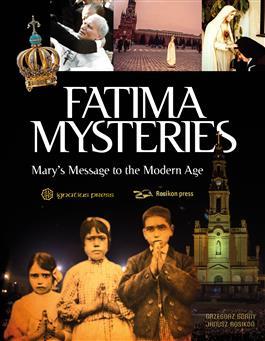
by Grzegorz Gorny and Janusz Rosikon
400 pages | Hardcover
"The tragedies foretold in Fatima did not come to an end with the demise of Communism. The crisis has not been resolved. From a certain point of view it is still as serious as it ever was, as it is primarily a crisis of faith, hence a moral and social crisis."
— Pope Benedict XVI
The apparitions in 1917 of the Blessed Virgin Mary to three peasant children in Fatima, Portugal, are perhaps the most important private revelations in the history of the Church. At the height of World War I and on the eve of the Russian Revolution, Our Lady appeared in Fatima to warn us of another even greater world war, the spread of Communism, and a terrible persecution of the Church unless people returned to God. She asked for us to offer daily prayer and sacrifice for conversion of the world and salvation of souls.
Because of the prophetic nature of Our Lady's messages and their potential significance for the entire world, they have been the subject of much study and controversy, and they have influenced the decisions not only of many individuals, but also of Popes, Bishops, and heads of state.
To celebrate the 100th anniversary of these important apparitions and messages for the modern world, renowned author-photographer team Grzegorz Górny and Janusz Rosikon traveled throughout Europe to tell the story of Fatima and its impact on the destiny of both individuals and nations. With stunningly beautiful four-color photographs on every page, and in-depth detail and insights on all aspects of the story and message of Fatima, they probe the mysteries of Fatima and their continued relevance for our modern age. Lavishly Illustrated.
Grzegorz Górny is a reporter, essayist, and film and television producer. He is the founder and editor-in-chief of the quarterly Fronda, and from 1994 to 2001 he co-authored a program under the same title that aired on the Polish national television. He has produced various documentary television series and authored numerous articles for European publications. His books include Battle for Madrid (2010).
Janusz Rosikon is a photographer and a member of the Association of Polish Artistic Photographers. His photographs have been featured in Time, Newsweek, and Reader's Digest.
"This is a very special book on the whole story, messages and meaning of Fatima. It is a great treasury of information and inspiration for the 100th anniversary of Fatima, filled with stunning photos and images. This book will help you to do what Pope Benedict XVI asked of us all - to learn, live and spread the message of Fatima!"
- Fr. Andrew Apostoli, C.F.R., Author, Fatima For Today
"What a masterpiece! Fatima Mysteries is the most comprehensive and thoroughly researched book I have ever read on the Fatima apparitions. It offers an historical, cultural, and theological presentation of everything there is to know about the importance of one of the greatest events in modern times."
- Fr. Donald Calloway, MIC, Author, Champions of the Rosary: The History and Heroes of a Spiritual Weapon
April 3, 2017
New: "Catholics and Protestants: What Can We Learn from Each Other?" by Peter Kreeft
Now available from Ignatius Press:
Catholics and Protestants: What Can We Learn from Each Other?
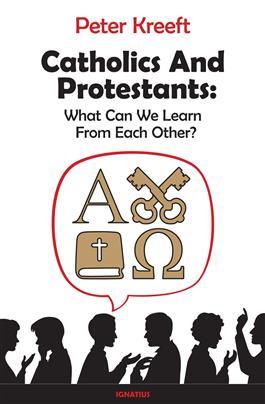
by Peter Kreeft
The widely read author and philosopher Peter Kreeft presents a unique book that focuses on the important beliefs that Catholics and Protestants share in common. He says this book is inspired by Christ's high priestly prayer in the Gospel of John "that they may be one," and by St. John Paul II's ecumenical encyclical, Ut Unum Sint, which is also based on Christ's prayer for unity. While there are still significant differences, Kreeft says that there has been a radical step of agreement on the single most important issue, justification.
Kreeft says the style of the book is that of Pascal, Nietzsche, Solomon, and Jesus: short answers, single points to ponder rather than long strings of argument. It is direct, simple, and confrontational, but vertically rather than horizontally, "directing arrows not against each other (Protestant or Catholic) but against our own hearts and minds and wills."
It is timely because, as Pope St. John Paul II said, this next millennium is destined to be the millennium of Christian reunification as the first millennium was that of Christian unity, and the second one of Christian disunity.
Above all, Kreeft says that this work is simple, not easy, or obvious, but condensed. It – like all of reality – is Christocentric. Its purpose is to be "like an Australian sheep dog, herding and hectoring Christ's separated sheep back to His face. For that is the only way they can ever return back to each other."
Peter Kreeft, Ph.D., Professor of Philosophy at Boston College, is one of the most widely read Christian authors of our time. His many bestselling books cover a vast array of topics in spirituality, theology, and philosophy. They include How to Be Holy, Practical Theology, Back to Virtue, Because God Is Real, You Can Understand the Bible, Angels and Demons, Heaven: The Heart's Deepest Longing, and A Summa of the Summa.
"Peter Kreeft has a remarkable gift for expressing complex issues in lucid, accurate, and pithy ways. He also has the fairness and insight needed to undertake a tractate to bring Catholics and Protestants into closer union. This book will no doubt help understanding and dialog between both."
— Robert J. Spitzer, S.J., Author, The Soul's Upward Yearning
"No one has taught me more about what healthy ecumenism looks like than the brilliant and eloquent Peter Kreeft. He is a peerless apologist for truth and has been an inspiration to me for over two decades on the happy and vital connections between serious Catholic and evangelical faith."
— Eric Metaxas, #1 New York Times Bestselling Author, Bonhoeffer; Host of the Eric Metaxas Show
"Readers will expect-- and be gratified to find -- what we always find in any work by Kreeft: thorough, solid, intelligent work, and agile prose style, brought to the service of dependable content. This book should help us to find a real step forward in the mutual understanding of these two sectors of the Ancient Faith."
— Thomas Howard, Author, On Being Catholic
"Peter Kreeft, one of our finest Christian writers today, has given us a passionate plea for Christian unity, one that builds upon the great common core of Christian belief confessed by faithful Protestants and Catholics alike. A volume full of faith-and hope."
— Timothy George, Dean of Beeson Divinity School of Samford University
"In his unique style, Kreeft avoids academic verbosity and cuts right to the chase. His uncanny ability to reduce the complex into readable text is like poetry in motion. Christians from various traditions will find this book a pleasure to read."
— Stephen Ray, Author, Crossing the Tiber
"If only this book had been written five hundred years ago! Peter Kreeft is a reliable sherpa, guiding us safely through the theological and historical impasses into which countless unwary Christians have stumbled."
— Patrick Madrid, Author, Life Lessons; Host of the Patrick Madrid Show
"This is a book that lives up to its title, and will be a useful resource for any Catholic with Protestant friends or colleagues - and vice versa. It invites the reader to explore these often contentious issues with respect for both perspectives, and with genuine hope for resolution and reunion."
— Holly Ordway, Author, Not God's Type
March 29, 2017
New: "That Nothing May Be Lost" by Rev. Paul D. Scalia
Now available from Ignatius Press:
That Nothing May Be Lost: Reflections on Catholic Doctrine and Devotion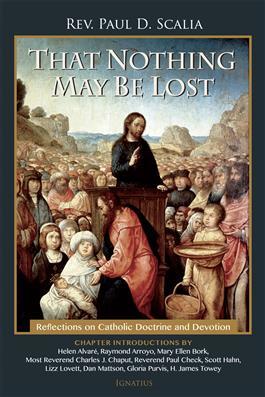
by Rev. Paul D. Scalia
Fr. Paul Scalia reveals a scholar's mind and a pastor's heart in these inspiring reflections on a wide range of Catholic teachings and practices. Rooted in Scripture, these insights place the reader on a path to a deeper, more meaningful relationship with God.
Among the topics explored are deepening one's knowledge of Jesus, partaking of the life of grace through the sacraments, and cultivating the art of prayer as a continuous conversation with God.
Each section is introduced by a moving essay by a highly regarded Catholic. Fr. Paul Check, Jim Towey, Scott Hahn, Mary Ellen Bork, Gloria Purvis, Raymond Arroyo, Lizz Lovett, Helen Alvaré, and Dan Mattson offer their personal accounts of being Catholic, which are followed by Fr. Scalia's illuminations. Archbishop Charles Chaput contributes a thought- provoking foreword, which begins the reader's exploration of the many important aspects of the Catholic faith presented in this book.
Fr. Paul Scalia, a native of Virginia, studied theology at the Pontifical Gregorian University and the Pontifical University of Saint Thomas Aquinas in Rome. Ordained in 1996, Fr. Scalia was appointed the Bishop's Delegate for Clergy in 2012. He has written for various publications and has served as a frequent contributor to the Arlington Catholic Herald and Encourage and Teach, the diocesan blog.
"Fr. Scalia has written a book that deepens our faith and leads us closer to God in a hundred different ways."
— Most Reverend Charles Chaput, Archbishop of Philadelphia, from the Foreword
"Fr. Scalia has a unique gift of taking stories from Scripture that we've heard many times and casting them into a whole new light. In this book he opens up Catholic teaching in fresh and sometimes surprising directions that will change the way you think about your faith."
— Carrie Gress, Author, Nudging Conversations
"It is the great joy of a priest to see the two people he loves most, the Lord Jesus and whichever person he is caring for at that moment, in each other's arms. It is my hope that the many reflections Fr. Scalia offers us in these pages will bring us all into the arms of the only One who can ultimately satisfy."
— Fr. John Riccardo, Author, Heaven Starts Now
"Sacraments are symbols that convey the reality they signify. All other signs remain distinct from the things they signify. Only sacraments bring about what they signify. Sacramental signs convey the sacred reality itself. There can be no more perfect communication than this. Only God could express Himself in this way."
— Scott Hahn, from the Introduction to Chapter IV, The Sacraments
"One of the blessings of being a Catholic is discovering we are part of a large extended family of holy people. Their stories cover many centuries and diverse cultures, and knowing them, we come to a better understanding of Christ, the One they loved and followed."
— Mary Ellen Bork, from the Introduction to Chapter VI, The Saints
"As I read my friend Fr. Paul's moving and rich reflections on various feast days, an image from my childhood returned. It is of a Corpus Christi procession through the French Quarter around St. Louis Cathedral. Once again that eternal clash of the sacred and the profane that the rest of the world tries to ignore or deny is made manifest. This is what feast days are all about: dedicated times for us to stop and experience the deeper spiritual reality beyond the blur of our chaotic lives."
— Raymond Arroyo, from the Introduction to Chapter IX, Feasts: The Pattern and Rhythm of the Christian Life
March 22, 2017
New: "Saint Aloysius Gonzaga, S.J.: With an Undivided Heart"
Now available from Ignatius Press:
Saint Aloysius Gonzaga, S.J.: With an Undivided Heart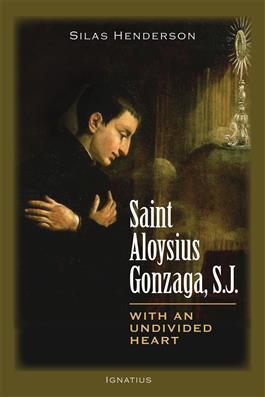
by Silas Henderson
Saint Aloysius Gonzaga (1568-1591) was a prince of the Holy Roman Empire who renounced his titles and wealth to serve God and the Church as a member of the Society of Jesus. While he lived a short life and is honored as the patron saint of youth, Saint Aloysius invites all Christians to reflect on how they are living their unique vocations to be witnesses to Christ.
Using the saint's own letters and spiritual reflections, and other historical documents, this book offers unparalleled insights into his life and personality. Woven together with his biography are also portraits of other Jesuits and Reformation saints. The author explains the history of the Society of Jesus and shows how Aloysius Gonzaga played an important part in developing the Jesuit's educational apostolate.
For those interested in Jesuit history, the Reformation, or simply this appealing saint, this book offers a unique perspective on an important period of Church history and what it means to pursue God's will without counting the cost.
Silas S. Henderson is a catechist, retreat leader, and the author of four other books (including Lights for a Waiting World: Celebrating Advent with the Saints and From Season to Season: A Book of Saintly Wisdom), as well as dozens of articles and reflections on prayer, spirituality, Mary, and the Saints.
"Most people don't understand the life of Saint Aloysius Gonzaga. But Silas Henderson reveals the complicated, brief, beautiful life that is still, perhaps especially, relevant today."
— Jon M. Sweeney, Author, When St. Francis Saved the Church
"This new biography of Aloysius Gonzaga gives us just what we need to grasp the nature of his sacrifices in leaving an aristocratic life for a fledgling religious community, and in risking his health by serving plague victims for the sake of Christ."
— Joseph Koterski, S.J., Professor of Philosophy, Fordham University
"The last thing in the world we might expect is a biography of a young man who, by current world standards, did not 'do' much. That is why this book and Gonzaga's life are so important for our times. We do not save the world by saving the world. We save the world by first attending to God in the time we are given. This is the great lesson of the life of Aloysius Gonzaga."
— James V. Schall, S. J., Professor Emeritus, Georgetown University
"Finally! An up-to-date, sensitive, and thoroughly researched biography of one of the Church's greatest saints. The life of Aloysius Gonzaga has sometimes been buried under excess layers of piety that could obscure who he was: a strong, tough and prayerful young man and a superb model for youth. An extraordinary story well told."
— James Martin, S. J., Author, The Jesuit Guide to Almost Everything
"Here is that rare book, which is full of scholarship and research yet profoundly touches the heart. Silas Henderson's words humanize and bring to life this lovable and loving saint, showing his single-hearted devotion. I highly recommend it to the young, and to all, as a call to purity of heart and charity."
— Deacon Eddie Ensley, Ph.D., Author, Everyday Mysticism
March 21, 2017
Did Jesus rise from the dead and go directly to heaven?

The Spiritual Resurrection Theory appears to be alive (ahem) and well at the Associated Press | Carl E. Olson | The Dispatch at CWR
The always excellent Terry Mattingly of Get Religion points out that the Associated Press reveals a bit of biblical and theological illiteracy in a March 20th piece about the renovations done to the shrine in the Church of the Holy Sepulcher in Jerusalem. The report begins in this way:
The tomb of Jesus has been resurrected to its former glory. Just in time for Easter, a Greek restoration team has completed a historic renovation of the Edicule, the shrine that tradition says houses the cave where Jesus was buried and rose to heaven.
The problematic phrase—"the shrine that tradition says houses the cave where Jesus was buried and rose to heaven"—is repeated in the photo caption. Mattingly writes:
OK, I know that this is complicated. Maybe there needs to be an expanded entry in the Associated Press Stylebook covering the events of Holy Week, Easter and the Ascension?
Attention AP corrections desk: Christians around the world do not believe that Jesus was "buried and rose to heaven" from the tomb cut into the stone of Gethsemane. They believe that he was buried there, was resurrected, then ascended to heaven 40 days later. Church tradition points to Mount Olivet as the site of the Ascension.
This very issue is addressed in one of the 75 or so questions found in my book Did Jesus Really Rise From the Dead?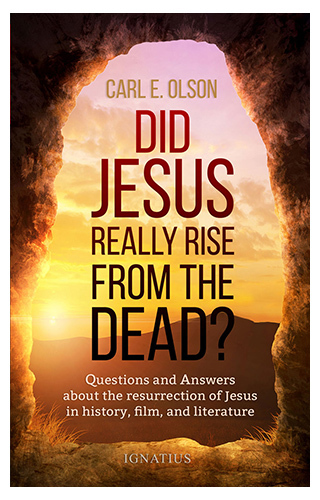 (Ignatius Press/Augustine Institute, 2016):
(Ignatius Press/Augustine Institute, 2016):
Q. Was the Resurrection also when Jesus ascended into Heaven and was exalted there by the Father?
This is a common misunderstanding, even among some Christians. It is even, as Brant Pitre points out [in The Case for Christ] remarkably popular “especially among scholars who do not believe in Jesus’ bodily resurrection. Nevertheless, this idea is (literally) dead wrong.” That is because the Ascension of Jesus into Heaven, as the creedal statements above indicate and Scripture clearly attest, took place forty days after the Resurrection; the two are entirely distinct events, even though the Ascension is made possible because of the Resurrection. The risen Jesus, in fact, told Mary Magdalene that he had not yet gone to the Father:
Jesus said to her, “Mary.” She turned and said to him in Hebrew, “Rabboni!” (which means Teacher). Jesus said to her, “Do not hold me, for I have not yet ascended to the Father; but go to my brethren and say to them, I am ascending to my Father and your Father, to my God and your God.” (Jn 20:16–17)
In addition, Luke begins Acts of the Apostles by stating, “To them he presented himself alive after his passion by many proofs, appearing to them during forty days, and speaking of the kingdom of God” (Acts 1:3).
The key point here is that the Resurrection was not a spiritual event only, during which Jesus was exalted, in some form, into Heaven; rather, it was a miraculous event in which Jesus was raised from the dead with real and glorified body, becoming “the first‐born from the dead” (Col 1:18; cf. Rev 1:5). And forty days separated that event from the Ascension, during which time Jesus, according to Paul, “appeared to Ce’phas, then to the Twelve. Then he appeared to more than five hundred brethren at one time, most of whom are still alive, though some have fallen asleep. Then he appeared to James, then to all the apostles” (1 Cor 15:5–7).
Mattingly reminds readers of a similar error made by The New York Times in a May 2013 piece about Pope Francis' first Urbi et Orbi message: "Easter is the celebration of the resurrection into heaven of Jesus, three days after he was crucified, the premise for the Christian belief in an everlasting life."
These sort of mistakes certainly betray sloppiness and a lack of basic knowledge, which is frustrating enough. But a deeper issue, I suspect, is the implicit assumption that the Resurrection is an entirely spiritual event, having little or nothing to do with the material realm. This general approach to the Resurrection can be described as the Spiritual Resurrection Theory; here is an excerpt from Chapter 9 ("Physical and Spiritual") of my book:
Q. What is the Spiritual Resurrection Theory?
This is the idea that the Resurrection of Jesus was purely spiritual and not at all corporeal or bodily. The risen Jesus was a spirit. Those who encountered him encountered the spirit of Jesus. His corpse is irrelevant, in this view. Whether dogs ate it or it remains buried in a tomb makes no difference. Jesus’s body wasn’t transformed; he was raised a spirit.
Q. Who advocates the idea of the Spiritual Resurrection Theory?
Some theologically liberal Christians espouse the Spiritual Resurrection Theory, or a form of it. It is held by John Shelby Spong, John Dominic Crossan, and Marcus Borg, among others. Jehovah’s Witnesses, oddly enough, also advocate a form of it. They think the various Resurrection appearances recounted in the New Testament do not reflect Jesus’s actual resurrected state, but involve various bodies he assumed or materialized in order to indicate to his disciples his continued existence as a spirit. Unlike most people who reject the traditional understanding of Jesus’s Resurrection, advocates of the Spiritual Resurrection Theory generally appeal to the New Testament to support their views. As a result, the case against the theory involves a careful review of certain New Testament passages.
There is much, much more, as you can see from the table of contents and the Introduction.
Carl E. Olson's Blog
- Carl E. Olson's profile
- 20 followers



